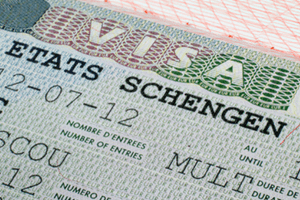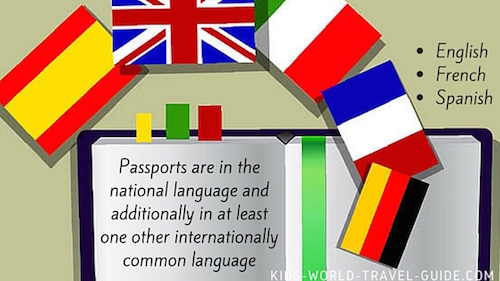- Homepage
- Passports
Passport Facts
Passport Facts | Kids World Travel Guide | Last updated: 16 January 2020
In our passport facts for kids you will find lots of useful information on passports and visa, written for children by children.
When travelling abroad, the most important item to take along is the passport. Remember that for most countries your passport must remain valid at least until three (often six) months upon arrival in the foreign country and the passport usually must have at least two blank pages to allow border control to put their stamps in.
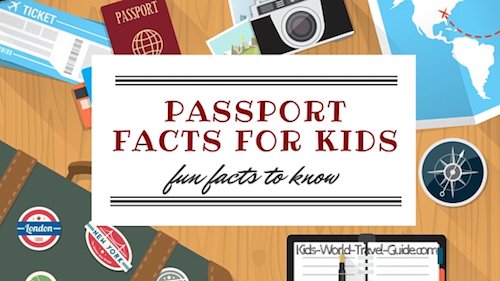
But let's start with some explanations and then read through our fascinating fun facts about passports.
Passport Facts: What is a passport?
A passport is an official travel document which shows that the person holding the passport is a citizen of this particular country. A passport offers the passport holder the possibility to travel abroad and enter and leave the country at own will and thus provides an internationally recognised personal travel document.
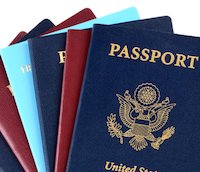
Passports contain in general:
- name and birth date of the passport holder
- birth place
- signature
- photo image
Nowadays, most passports include biometric data. This means when applying for a passport you have to provide information on your hight, eye colour and have your fingerprints taken and have a photo or scan of your face. This information is then stored on an embedded chip on the card or paper fixed into your passport. This feature helps to avoid criminal activity as it is a deterrent of identity fraud.
Passport and Visa Facts
Countries allow foreign people to cross their borders and grant access to their 'territory' when these foreign visitors show their passports to border officials. Usually passports do not automatically allow entry and often special visa have to applied for either before travelling or on arrival when presenting at a foreign country's border control.
For immigration control many countries add entry and exit stamps onto the passport pages. See some stamps below. Can you find out which countries issued the stamps?
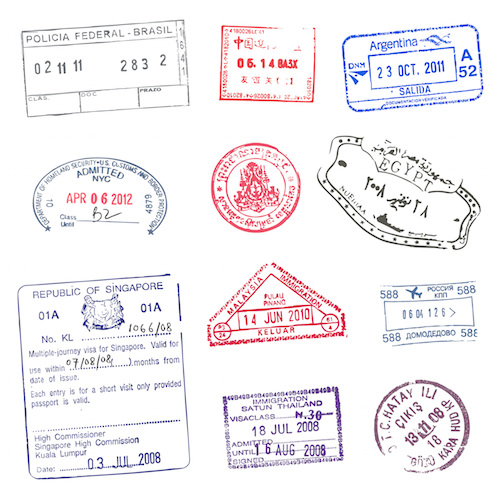
 Chinese passport from 1898
Chinese passport from 1898Interesting passport facts: To ask for permission when travelling to foreign places is a very old custom that dates back as far as 450 BCE. Then the Persian king provided granted leave to travel across foreign land to one of his servants.
The first official travel documents were however issued by the British in the 16th century. King Henry V of England, provided the first regulations concerning travelling citizens. If people then could not show their documents when passing through a city's gate or when passing posts while travelling through the land, they could even face exile!
Visa Facts for Kids
As mentioned above, many countries require not only a passport but also a visa for entry. Visa are often to be applied for before travelling and when entering the country, stamps are issued into the passport to show entry and validity dates of the visa.
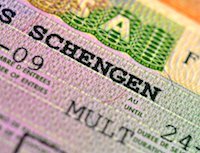
Some countries, such as the countries belonging to the European Union, issue a visa which is valid for all the participating countries. The EU countries' visa is called Schengen Visa.
Did you know that for entry to the USA, there are 20 visa types available? The category people have to apply for depends on the purpose of the travels. Foreigners who want to visit the country for a holiday travels will need to apply for a different visa than people who come to the USA to open a new business or students who plan to take up studies at one of the American universities.
However, some stamps are really tricky! So precautions have to be taken by some international travellers. If they want to travel to China, they better do not visit Nepal before. Visitors to some Arab countries might not be welcome if their passport shows a stamp from Israel.
Dual citizenship
Dual citizenship is when people are a national citizen of two countries and thus hold more than one country's passport. Often this is the case if a child is born to parents of different nationalities or sometimes also if a child is born in a country that is not the home country of the parents. Sometimes the child might be able to obtain a passport of the country where it is born even if both parents are not citizens of this country such as when children are born in New Zealand or the USA, they can automatically claim citizenship in these countries. This special status is only allowed in some countries but is not supported in all nations.
Travelling with dual citizenship is not always easy. Should you have for example a South African and an U.S. passport, then you must enter and leave the USA with the US passport and enter and leave South Africa with the South African passport.
Well, also in different countries, different rules apply! So always make sure which passport is needed for your travels should you be lucky enough to be citizen of more than one country.
Interesting passport facts: Remember, that usually passports expire after a period of ten years and thus need to be extended in time prior to your travels. Sometimes passports are valid a more limited time, such as for German children's passports which have to be renewed at the age of 6 and from 12 years, children need to get a regular German passport. Make sure to know which regulations apply in your country!
12 Fascinating and Fun Passport Facts
- According to Passport Index, the passport of the United Arab Emirates is the most powerful passport in the world. The Emirati passport allows travel to 170 countries without visa.
- Only half of all U.S. Americans have a passport and this shows that also American generally love travelling, most of them travel inside their own country and have never been abroad.
- In 1783, Benjamin Franklin ordered the first US passports to be printed.
- Every 2.5 seconds one UK passport is printed! This allows for 5 million passports to be printed each year in the UK.
- The UK passport is dubbed the 'red book', while the US passport is often referred to as the 'blue book'.
- Passports are usually printed at top secret locations, however, not all passports are printed in the country they represent.
- Standard passports contain 52 pages in most countries.
- In many countries children need to have their own passport for travels. Passports for children are required to be carried in Canada and South Africa for example. In some countries, passports for children only remain valid for shorter periods (makes it easier to recognise a child on the image;-) or until a child turns 16 years old.
- Most passports are printed in at least two or three languages, that is in the national language and additionally mainly in English, some also in French and Spanish.
- The most expensive passports are from Australia in 2022.
- According to old customs, most country's passports include a request page, with a text requesting from other nations that passport holders are allowed to pass freely and be granted support when needed. This message is not included in Swiss and Austrian passports!
- Citizens of the Vatican state in Italy (the smallest country in the world!) carry passports, but there are no immigration control or border posts.
Further Reading
Resources for Passport Facts
Sources for Passport Facts page and recommended reading:
- U.S. Department of State. "Reports and Statistics - U.S. Passports". Travel.State.gov. Accessed 10 June 2022
- Global Passport Power Rank. "Passport Index 2022". PassportIndex.org. Accessed 10 June 2022.
- Australian Government. "2022 Passport Fee". Australian Passport Office. Accessed 10 June 2022
- The Post Office. "Renew a Passport". UK Post Office. Accessed 10 June 2022
Image Credits for Passport Facts page: Shutterstock and own images
Return from Passport Facts to Kids World Travel Guide Homepage
Do you like what you read?

|
Let your friends know! Copy and paste into mails and onto your website, blog or Facebook page: |
